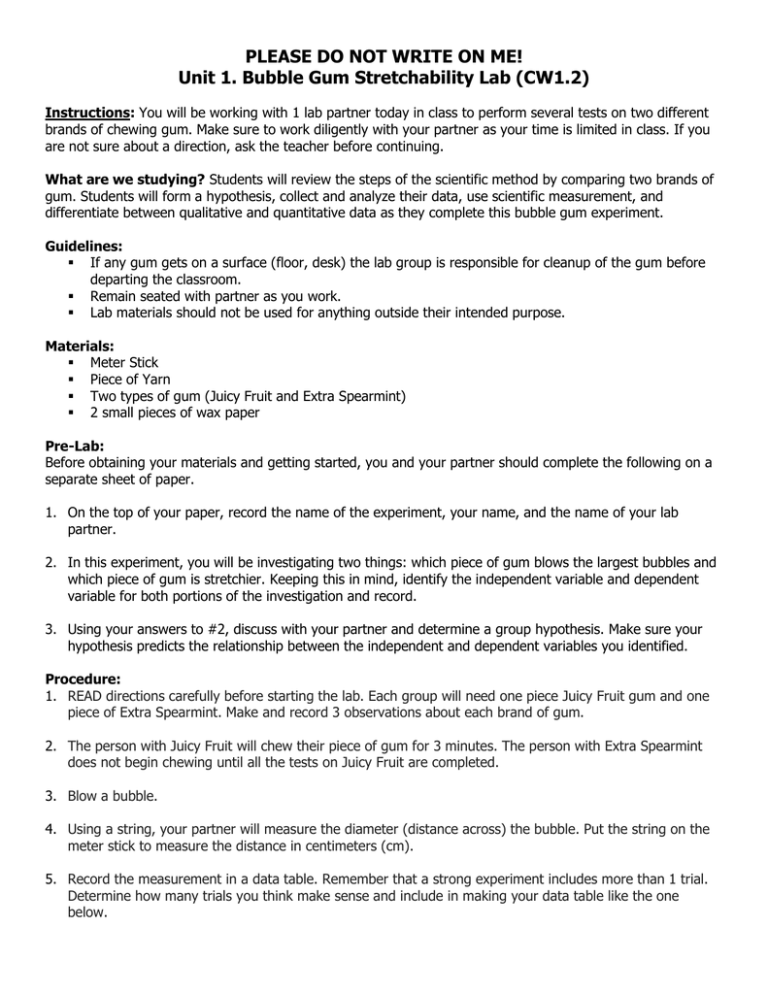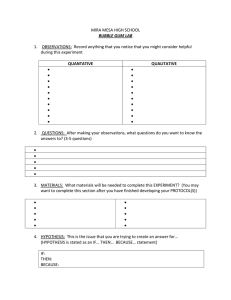Unit 1. Day 3. Bubble Gum Stretchability Lab Handout
advertisement

PLEASE DO NOT WRITE ON ME! Unit 1. Bubble Gum Stretchability Lab (CW1.2) Instructions: You will be working with 1 lab partner today in class to perform several tests on two different brands of chewing gum. Make sure to work diligently with your partner as your time is limited in class. If you are not sure about a direction, ask the teacher before continuing. What are we studying? Students will review the steps of the scientific method by comparing two brands of gum. Students will form a hypothesis, collect and analyze their data, use scientific measurement, and differentiate between qualitative and quantitative data as they complete this bubble gum experiment. Guidelines: If any gum gets on a surface (floor, desk) the lab group is responsible for cleanup of the gum before departing the classroom. Remain seated with partner as you work. Lab materials should not be used for anything outside their intended purpose. Materials: Meter Stick Piece of Yarn Two types of gum (Juicy Fruit and Extra Spearmint) 2 small pieces of wax paper Pre-Lab: Before obtaining your materials and getting started, you and your partner should complete the following on a separate sheet of paper. 1. On the top of your paper, record the name of the experiment, your name, and the name of your lab partner. 2. In this experiment, you will be investigating two things: which piece of gum blows the largest bubbles and which piece of gum is stretchier. Keeping this in mind, identify the independent variable and dependent variable for both portions of the investigation and record. 3. Using your answers to #2, discuss with your partner and determine a group hypothesis. Make sure your hypothesis predicts the relationship between the independent and dependent variables you identified. Procedure: 1. READ directions carefully before starting the lab. Each group will need one piece Juicy Fruit gum and one piece of Extra Spearmint. Make and record 3 observations about each brand of gum. 2. The person with Juicy Fruit will chew their piece of gum for 3 minutes. The person with Extra Spearmint does not begin chewing until all the tests on Juicy Fruit are completed. 3. Blow a bubble. 4. Using a string, your partner will measure the diameter (distance across) the bubble. Put the string on the meter stick to measure the distance in centimeters (cm). 5. Record the measurement in a data table. Remember that a strong experiment includes more than 1 trial. Determine how many trials you think make sense and include in making your data table like the one below. Trial # Juicy Fruit Bubble Diameter (cm) Extra Spearmint Bubble Diameter (cm) as many rows as your group determined trials in step 5 above Average 6. Find the average bubble size for Juicy Fruit (add all the distances up and divide by number of trials) and put in the data chart. 7. Repeat steps 1-6 with brand Extra Spearmint. 8. Which brand of gum appears best at blowing bubbles and why? Support your answer with observations and your data. Was your initial hypothesis supported by the data? Why or why not? Record your answers on your paper. PART 2: Combine with another partner group to complete this portion of the experiment. 9. The person with Juicy Fruit will roll their gum into a ball. 10. Hold the gum (Juicy Fruit) by using the piece of wax paper. Your partner should hold the same piece of gum with another piece of wax paper. Hold the gum near your chest and begin to walk slowly backwards. 11. The third person in the group should hold the meter stick and measure the distance in centimeters the gum stretched before breaking. 12. Make a new data table to record your stretchability measurements. ONLY DO ONE TRIAL for each gum. 13. Repeat #9 - 11 for Extra Spearmint gum. Analysis and Conclusion: 14. How does gum stretchability appear to relate to bubble size? 15. With your lab partner, list 3 variables that may affect the outcome of this experiment. 16. Explain how the data you collected can be described as both qualitative and quantitative. 17. If you were to complete this experiment or a similar one again in the future, how might you add to this procedure to obtain more verifiable results?




